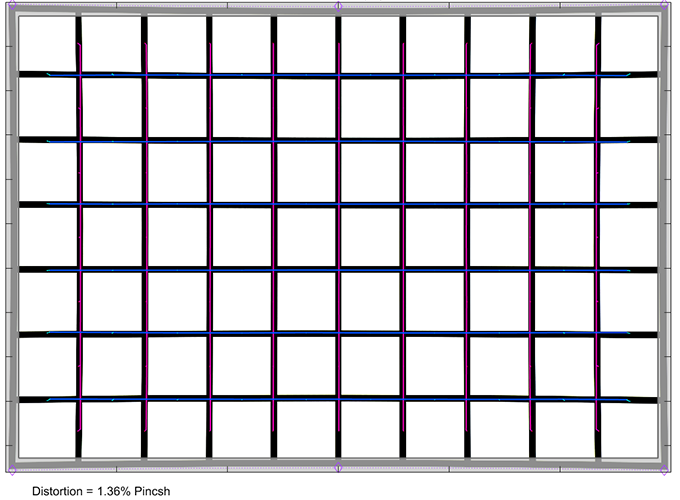|
Tokina atx-m 56mm f/1.4 E - Review / Test Report - Analysis |
|
Lens Reviews -
Sony Alpha/NEX (APS-C)
|
|
Page 2 of 3

Distortion
As mentioned, the Tokina lens doesn't include a built-in correction profile thus you have to live with the raw optical performance. Eventually, you may see a correction profile in your favorite RAW converter, but that's not guaranteed, of course.
The lens produces a medium pincushion of ~1.4%. While not ideal, this remains within acceptable limits for most applications.

Vignetting
The vignetting characteristic of the Tokina atx-m 56mm f/1.4 E is quite heavy at f/1.4, but that's to be expected from an f/1.4 lens. Stopped down to f/2 reduces this substantially, and it's not a big deal anymore from f/2.8 onward.
Note: Unlike to the Fujifilm version, the raw vignetting is true to expectations here.

MTF (resolution)
The Tokina lens provides a solid performance on a 24-megapixel sensor, albeit not flawless. At f/1.4, the center performance is already excellent quality, although that's probably not a show-stopper in this lens class. The overall contrast level is also somewhat reduced at this setting. Stopping down to f/2 also lifts the broader center to excellent levels. The center reaches its peak performance at f/2.8. The quality of the outer image field increases gradually with decent results at f/2.8 and the best (very sharp) quality at f/5.6 and f/8. Diffraction effects are setting in beyond (not shown).
The field curvature is marginal. The centering quality of the tested sample was good.
Please note that the MTF results are not directly comparable across the different systems!
Below is a simplified summary of the formal findings. The chart shows line widths
per picture height (LW/PH) which can be taken as a measure for sharpness.
If you want to know more about the MTF50 figures you may check out the corresponding
Imatest Explanations

Chromatic Aberrations (CAs)
Lateral CA (color shadows at the image borders) are well controlled with an average pixel width peaking just below 1px mark at the image borders at f/1.4 and lower CAs are medium aperture settings.

Bokeh
While sheer sharpness is certainly an important criterion, you rarely buy an ultra-fast lens for it alone. The primary application tends to be shallow depth-of-field photography, and bokeh quality should be a priority in your purchasing decision. So how does the Tokina lens perform in this respect?
Out-of-focus highlights are beautifully rendered in the image center with no outlining and a very smooth inner zone. A more edgy aperture shape is already visible at f/2, and it's getting more obvious from f/2.8 onward.
 The images below illustrate the deterioration of the out-of-focus highlights towards the image corners. The circular shape is kept across a very broad image field with only an obvious deterioration in the corners. The corner highlight shape improves when taking shots at f/2.8 other than becoming edgier.
The low vignetting figures, as well as the broad zone of circular highlights, suggest that the Tokina lens can cover more than just the APS-C image circle, although it's probably not enough for full-frame.
The general rendition in the focus transition zones is smooth in the image background but somewhat more edgy in the foreground.
The images below illustrate the deterioration of the out-of-focus highlights towards the image corners. The circular shape is kept across a very broad image field with only an obvious deterioration in the corners. The corner highlight shape improves when taking shots at f/2.8 other than becoming edgier.
The low vignetting figures, as well as the broad zone of circular highlights, suggest that the Tokina lens can cover more than just the APS-C image circle, although it's probably not enough for full-frame.
The general rendition in the focus transition zones is smooth in the image background but somewhat more edgy in the foreground.

Bokeh Fringing (LoCA)
Bokeh fringing - also referred to as LoCAs - is a color fringing effect on the Z-axis. It shows up as purplish halos in front of the in-focus zone and greenish beyond. The effect is clearly visible at f/1.4 and f/2 and starts fading at f/2.8 - this is a typical behavior for a non-APO lens although somewhat higher than usual here.
|